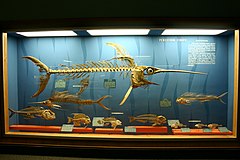Perciformes
This article needs additional citations for verification. (August 2010) |
| Perciformes Temporal range: Late Cretaceous to Recent
| |
|---|---|

| |
| Scientific classification | |
| Kingdom: | |
| Phylum: | |
| Class: | |
| Infraclass: | |
| Superorder: | |
| Order: | Perciformes Bleeker, 1859
|
| Type species | |
| Perca fluviatilis | |
Perciformes, also called the Percomorphi or Acanthopteri, are the largest order of vertebrates, containing about 41% of all bony fish. Perciformes means "perch-like". They belong to the class of ray-finned fish, and comprise over 10,000 species found in almost all aquatic ecosystems.
The order contains about 160 families, which is the most of any order within the vertebrates.[1] It is also the most variably sized order of vertebrates, ranging from the 7-mm (1/4-in) Schindleria brevipinguis to the marlin in the Makaira genus. They first appeared and diversified in the Late Cretaceous.
Among the well-known members of this group are cichlids, California sheephead, bluegill, damselfish, bass, and perch.
Characteristics
The dorsal and anal fins are divided into anterior spiny and posterior soft-rayed portions, which may be partially or completely separated. The pelvic fins usually have one spine and up to five soft rays, positioned unusually far forward under the chin or under the belly. Scales are usually ctenoid, although sometimes they are cycloid or otherwise modified.
Taxonomy
Classification is controversial. As traditionally[vague] defined, the Perciformes are almost certainly paraphyletic. Other orders that should possibly be included as suborders are the Scorpaeniformes, Tetraodontiformes, and Pleuronectiformes. Of the presently recognized suborders, several may be paraphyletic, as well. These are grouped by suborder/superfamily, generally following the text Fishes of the World.[1][2][3]
- Suborder Percoidei
- Superfamily Percoidea
- Acropomatidae (Temperate ocean-basses)
- Ambassidae (Asiatic glassfishes)
- Apogonidae (Cardinalfishes)
- Arripidae (Australasian salmon)
- Badidae (Chameleonfishes)
- Banjosidae (Banjofish)

Perciformes display at the Smithsonian Museum of Natural History. - Bathyclupeidae (Deepsea herrings)
- Bramidae (Pomfrets)
- Caesionidae (Fusiliers)
- Callanthiidae (Splendid perches)
- Carangidae (Jacks)
- Caristiidae (Manefishes)
- Centrarchidae (Freshwater sunfishes)
- Centrogenyidae (False scorpionfishes)
- Centropomidae (Snooks)
- Chaetodontidae (Butterflyfishes)
- Coryphaenidae (Dolphinfishes)
- Datnioididae (Tigerfishes)
- Dichistiidae (Galjoen fishes)
- Dinolestidae (Long-finned pike)
- Dinopercidae (Cavebass)
- Drepaneidae (Sicklefishes)
- Echeneidae (Remoras)
- Emmelichthyidae (Rovers)
- Enoplosidae (Old wife)
- Epigonidae (Deepwater cardinalfishes)
- Gerreidae (Mojarras)
- Glaucosomatidae (Pearl perches)
- Grammatidae (Basslets)
- Haemulidae (Grunts)
- Howellidae (Oceanic basslets)
- Inermiidae (Bonnetmouths)
- Kuhliidae (Flagtails)
- Kyphosidae (Sea chubs)
- Lactariidae (False trevallies)
- Lateolabracidae (Temperate bass)
- Latidae (Lates)
- Leiognathidae (Ponyfishes)
- Leptobramidae (Beachsalmon)
- Lethrinidae (Emperor breams)
- Lobotidae (Tripletails)
- Lutjanidae (Snappers)
- Malacanthidae (Tilefishes)
- Menidae (Moonfish)
- Monodactylidae (Moonyfishes)
- Moronidae (Temperate basses)
- Mullidae (Goatfishes)
- Nandidae (Asian leaffishes)
- Nematistiidae (Roosterfish)
- Nemipteridae (Threadfin breams)
- Opistognathidae (Jawfishes)
- Oplegnathidae (Knifejaws)
- Ostracoberycidae (Shellskin alfonsinos)
- Parascorpididae (Jutjaws)
- Pempheridae (Sweepers)
- Pentacerotidae (Armorheads)
- Percichthyidae (Temperate perches)
- Percidae (Perches)
- Plesiopidae (Roundheads)
- Polycentridae (Leaffishes)
- Polynemidae (Threadfins)
- Polyprionidae (Wreckfishes)
- Pomacanthidae (Marine angelfishes)

Pomacanthus semicirculatus - Pomatomidae (Bluefish)
- Priacanthidae (Bigeyes)
- Pristolepididae (Asian leaffishes)
- Pseudochromidae (Dottybacks)
- Rachycentridae (Cobia)
- Sciaenidae (Croakers)
- Scombropidae (Gnomefish)
- Serranidae (Grouper, Comber, Perchlet)
- Sillaginidae (Whitings)
- Sparidae (Sea breams)
- Symphysanodontidae (Slopefishes)
- Terapontidae (Grunters)
- Toxotidae (Archerfishes)
- Superfamily Cirrhitoidea
- Aplodactylidae (Marblefishes)
- Cheilodactylidae (Morwongs)
- Chironemidae (Kelpfishes)
- Cirrhitidae (Hawkfishes)
- Latridae (Trumpeters)
- Superfamily Cepoloidea
- Cepolidae (Bandfishes)
- Superfamily Percoidea
- Suborder Elassomatoidei
- Elassomatidae (Pygmy sunfishes)
- Suborder Labroidei
- Cichlidae (Cichlids)
- Embiotocidae (Surfperches)
- Labridae (Wrasses)
- Odacidae (Cales)
- Pomacentridae (Damselfishes)
- Scaridae (Parrotfishes)
- Suborder Zoarcoidei
- Anarhichadidae (Wolffishes)
- Bathymasteridae (Ronquils)
- Cryptacanthodidae (Wrymouths)
- Pholidae (Gunnels)
- Ptilichthyidae (Quillfish)
- Scytalinidae (Graveldiver)
- Stichaeidae (Pricklebacks)
- Zaproridae (Prowfish)
- Zoarcidae (Eelpouts)
- Suborder Notothenioidei (sometimes included in Percoidei)
- Artedidraconidae (Barbeled plunderfishes)
- Bathydraconidae (Antarctic dragonfishes)
- Bovichthyidae (Thornfishes)
- Channichthyidae (Crocodile icefishes)
- Eleginopsidae (Patagonian blennies)
- Harpagiferidae (Spiny plunderfishes)
- Nototheniidae (Cod icefishes)
- Pseudaphritidae (Catadromous icefishes)
- Suborder Trachinoidei
- Ammodytidae (Sand lances)
- Champsodontidae (Crocodile toothfishes)
- Cheimarrhichthyidae (Torrent fish)
- Chiasmodontidae (Snaketooth fishes)
- Creediidae (Sandburrowers)
- Leptoscopidae (Southern sandfishes)
- Percophidae (Duckbills)
- Pholidichthyidae (Convict blennies)
- Pinguipedidae (Sandperches)
- Trachinidae (Weeverfishes)
- Trichodontidae (Sandfishes)
- Trichonotidae (Sanddivers)
- Uranoscopidae (Stargazers)
- Suborder Blennioidei
- Blenniidae (Combtooth blennies)
- Chaenopsidae (Flagblennies)
- Clinidae (Clinids)
- Dactyloscopidae (Sand stargazers)
- Labrisomidae (Labrisomids)
- Tripterygiidae (Threefin blennies)
- Suborder Icosteoidei
- Icosteidae (Ragfish)
- Suborder Callionymoidei
- Callionymidae (Dragonets)
- Draconettidae (Slope dragonets)
- Suborder Gobioidei
- Eleotridae (Sleepers)
- Gobiidae (Gobies)
- Kraemeriidae (Sand darters)
- Microdesmidae (Wormfishes)
- Odontobutidae (Freshwater sleepers)
- Rhyacichthyidae (Loach gobies)
- Schindleriidae (Infantfishes)
- Xenisthmidae (Collared wrigglers)
- Suborder Kurtoidei
- Kurtidae (Nurseryfishes)
- Suborder Acanthuroidei
- Acanthuridae (Surgeonfishes)
- Ephippidae (Spadefishes)
- Luvaridae (Louvar)
- Scatophagidae (Scats)
- Siganidae (Rabbitfishes)
- Zanclidae (Moorish idol)
- Suborder Scombrolabracoidei
- Scombrolabracidae (Longfin escolar)
- Suborder Scombroidei
- Sphyraenidae (Barracudas)
- Gempylidae (Snake mackerels)
- Trichiuridae (Cutlassfishes)
- Scombridae (Mackerels)
- Xiphiidae (Swordfish)
- Istiophoridae (Marlins)
- Suborder Stromateoidei
- Amarsipidae (Bagless glassfish)
- Ariommatidae (Ariommatids)
- Centrolophidae (Medusafishes)
- Nomeidae (Driftfishes)
- Tetragonuridae (Squaretails)
- Stromateidae (Butterfishes)
- Suborder Anabantoidei
- Anabantidae (Climbing gouramies)
- Osphronemidae (Gouramies)
- Helostomatidae (Kissing gourami)
- Suborder Channoidei
- Channidae (Snakeheads)
- Suborder Caproidei
- Caproidae (Boarfishes)
References
- ^ a b Nelson, J. S. (2006). Fishes of the World (4 ed.). Hoboken, NJ: John Wiley & Sons. ISBN 978-0-471-25031-9.
- ^ Froese, Rainer, and Daniel Pauly, eds. (2015). "Perciformes" in FishBase. August 2015 version.
- ^ "ADW: Perciformes". http://animaldiversity.ummz.umich.edu. Animal Diversity Web.
{{cite web}}: External link in|work=


